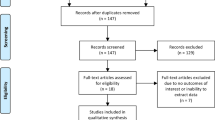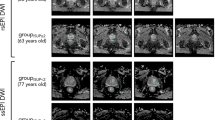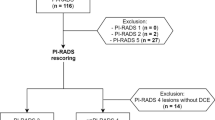Abstract
To study the staging accuracy of multiparametric magnetic resonance imaging (MRI) in patients showing unilateral low-risk cancer on prostate biopsy. A total of 58 consecutive patients with low-risk cancer (D'Amico classification) and unilateral cancer involvement on prostate biopsies were included prospectively. All patients underwent multiparametric endorectal MRI before radical prostatectomy, including T2-weighted (T2W), diffusion-weighted (DW) and dynamic contrast enhanced (DCE) sequences. Each gland was divided in eight octants. Tumor foci >0.2 cm3 identified on pathological analysis were matched with MRI findings. Pathological examination showed tumor foci >0.2 cm3 in 50/58 glands (86%), and bilateral tumor (pathological stage⩾pT2c) in 20/58 (34%). For tumor detection in the peripheral zone (PZ), T2W+DWI+DCE performed significantly better than T2W+DWI and T2W alone (P<0.001). In the transition zone (TZ), only T2W+DWI performed better than T2W alone (P=0.02). With optimal MR combinations, tumor size was correctly estimated in 77% of tumor foci involving more than one octant. Bilateral tumors were detected in 80% (16/20) of cases. In patients with unilateral low-risk prostate cancer on biopsy, multiparametric MRI can help to predict bilateral involvement. Multiparametric MRI may therefore have a prognostic value and help to determine optimal treatment in such patients.
This is a preview of subscription content, access via your institution
Access options
Subscribe to this journal
Receive 4 print issues and online access
$259.00 per year
only $64.75 per issue
Buy this article
- Purchase on Springer Link
- Instant access to full article PDF
Prices may be subject to local taxes which are calculated during checkout


Similar content being viewed by others
References
Noldus J, Graefen M, Haese A, Henke RP, Hammerer P, Huland H . Stage migration in clinically localized prostate cancer. Eur Urol 2000; 38: 74–78.
Epstein JI, Walsh PC, Carmichael M, Brendler CB . Pathologic and clinical findings to predict tumor extent of nonpalpable (stage T1c) prostate cancer. JAMA 1994; 271: 368–374.
Stamey TA, Freiha FS, McNeal JE, Redwine EA, Whittemore AS, Schmid HP . Localized prostate cancer. Relationship of tumor volume to clinical significance for treatment of prostate cancer. Cancer 1993; 71: 933–938.
Scattoni V, Zlotta A, Montironi R, Schulman C, Rigatti P, Montorsi F . Extended and saturation prostatic biopsy in the diagnosis and characterisation of prostate cancer: a critical analysis of the literature. Eur Urol 2007; 52: 1309–1322.
Giannarini G, Autorino R, di Lorenzo G . Saturation biopsy of the prostate: why saturation does not saturate. Eur Urol 2009; 56: 619–621.
Seitz M, Shukla-Dave A, Bjartell A, Touijer K, Sciarra A, Bastian PJ et al. Functional magnetic resonance imaging in prostate cancer. Eur Urol 2009; 55: 801–814.
van As NJ, de Souza NM, Riches SF, Morgan VA, Sohaib SA, Dearnaley DP et al. A Study of Diffusion-Weighted Magnetic Resonance Imaging in Men with Untreated Localised Prostate Cancer on Active Surveillance. Eur Urol 2009; 56: 981–987.
Alonzi R, Padhani AR, Allen C . Dynamic contrast enhanced MRI in prostate cancer. Eur J Radiol 2007; 63: 335–350.
Langer DL, van der Kwast TH, Evans AJ, Trachtenberg J, Wilson BC, Haider MA . Prostate cancer detection with multi-parametric MRI: logistic regression analysis of quantitative T2, diffusion-weighted imaging, and dynamic contrast-enhanced MRI. J Magn Reson Imaging 2009; 30: 327–334.
D'Amico AV, Renshaw AA, Cote K, Hurwitz M, Beard C, Loffredo M et al. Impact of the percentage of positive prostate cores on prostate cancer-specific mortality for patients with low or favorable intermediate-risk disease. J Clin Oncol 2004; 22: 3726–3732.
Tofts PS, Brix G, Buckley DL, Evelhoch JL, Henderson E, Knopp MV et al. Estimating kinetic parameters from dynamic contrast-enhanced T(1)-weighted MRI of a diffusable tracer: standardized quantities and symbols. J Magn Reson Imaging 1999; 10: 223–232.
Weinmann HJ, Laniado M, Mutzel W . Pharmacokinetics of GdDTPA/dimeglumine after intravenous injection into healthy volunteers. Physiol Chem Phys Med NMR 1984; 16: 167–172.
Chen ME, Johnston D, Reyes AO, Soto CP, Babaian RJ, Troncoso P . A streamlined three-dimensional volume estimation method accurately classifies prostate tumors by volume. Am J Surg Pathol 2003; 27: 1291–1301.
Villers A, Puech P, Mouton D, Leroy X, Ballereau C, Lemaitre L . Dynamic contrast enhanced, pelvic phased array magnetic resonance imaging of localized prostate cancer for predicting tumor volume: correlation with radical prostatectomy findings. J Urol 2006; 176: 2432–2437.
Epstein JI, Allsbrook Jr WC, Amin MB, Egevad LL . The 2005 International Society of Urological Pathology (ISUP) Consensus Conference on Gleason Grading of Prostatic Carcinoma. Am J Surg Pathol 2005; 29: 1228–1242.
Kozlowski P, Chang SD, Jones EC, Berean KW, Chen H, Goldenberg SL . Combined diffusion-weighted and dynamic contrast-enhanced MRI for prostate cancer diagnosis--correlation with biopsy and histopathology. J Magn Reson Imaging 2006; 24: 108–113.
Tanimoto A, Nakashima J, Kohno H, Shinmoto H, Kuribayashi S . Prostate cancer screening: the clinical value of diffusion-weighted imaging and dynamic MR imaging in combination with T2-weighted imaging. J Magn Reson Imaging 2007; 25: 146–152.
Zelhof B, Pickles M, Liney G, Gibbs P, Rodrigues G, Kraus S et al. Correlation of diffusion-weighted magnetic resonance data with cellularity in prostate cancer. BJU Int 2009; 103: 883–888.
Lemaitre L, Puech P, Poncelet E, Bouye S, Leroy X, Biserte J et al. Dynamic contrast-enhanced MRI of anterior prostate cancer: morphometric assessment and correlation with radical prostatectomy findings. Eur Radiol 2009; 19: 470–480.
Cornud F, Beuvon F, Thevenin F, Chauveinc L, Vieillefond A, Descazeaux A et al. Quantitative dynamic MRI and localisation of non-palpable prostate cancer. Prog Urol 2009; 19: 401–413.
Girouin N, Mege-Lechevallier F, Tonina Senes A, Bissery A, Rabilloud M, Marechal JM et al. Prostate dynamic contrast-enhanced MRI with simple visual diagnostic criteria: is it reasonable? Eur Radiol 2007; 17: 1498–1509.
Haider MA, van der Kwast TH, Tanguay J, Evans AJ, Hashmi A-T, Lockwood G et al. Combined T2-Weighted and Diffusion-Weighted MRI for Localization of Prostate Cancer. Am J Roentgenol 2007; 189: 323–328.
Yoshizako T, Wada A, Hayashi T, Uchida K, Sumura M, Uchida N et al. Usefulness of diffusion-weighted imaging and dynamic contrast-enhanced magnetic resonance imaging in the diagnosis of prostate transition-zone cancer. Acta Radiol 2008; 49: 1207–1213.
deSouza NM, Riches SF, Vanas NJ, Morgan VA, Ashley SA, Fisher C et al. Diffusion-weighted magnetic resonance imaging: a potential non-invasive marker of tumour aggressiveness in localized prostate cancer. Clin Radiol 2008; 63: 774–782.
Author information
Authors and Affiliations
Corresponding author
Ethics declarations
Competing interests
N Muradyan is employed by iCAD. No financial disclosure from any authors.
Rights and permissions
About this article
Cite this article
Delongchamps, N., Beuvon, F., Eiss, D. et al. Multiparametric MRI is helpful to predict tumor focality, stage, and size in patients diagnosed with unilateral low-risk prostate cancer. Prostate Cancer Prostatic Dis 14, 232–237 (2011). https://doi.org/10.1038/pcan.2011.9
Received:
Revised:
Accepted:
Published:
Issue Date:
DOI: https://doi.org/10.1038/pcan.2011.9
Keywords
This article is cited by
-
A systematic review and meta-analysis of the diagnostic accuracy of biparametric prostate MRI for prostate cancer in men at risk
Prostate Cancer and Prostatic Diseases (2021)
-
Prostate cancer detection with biparametric magnetic resonance imaging (bpMRI) by readers with different experience: performance and comparison with multiparametric (mpMRI)
Abdominal Radiology (2019)
-
Short review of biparametric prostate MRI
memo - Magazine of European Medical Oncology (2018)
-
Multiparametric prostate MRI: focus on T2-weighted imaging and role in staging of prostate cancer
Abdominal Radiology (2016)
-
Practical aspects of prostate MRI: hardware and software considerations, protocols, and patient preparation
Abdominal Radiology (2016)



